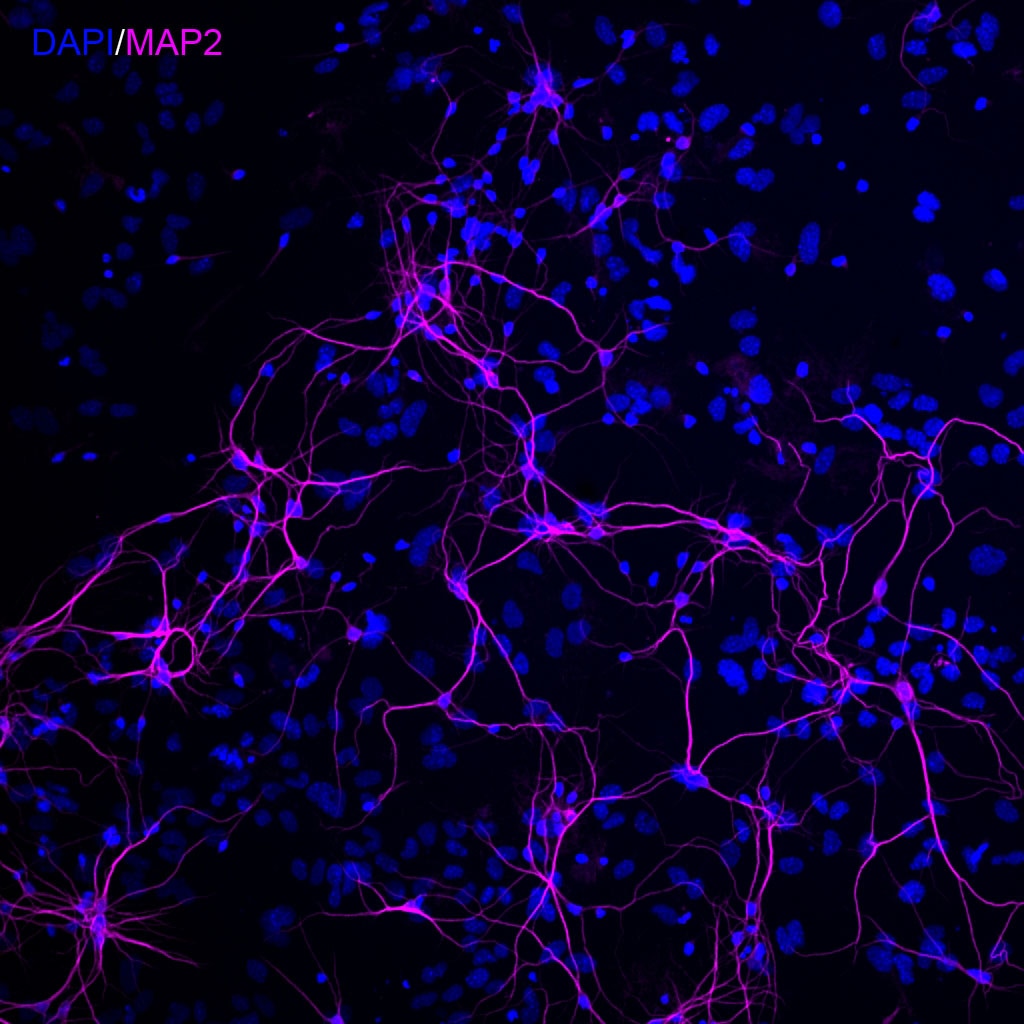| Reactivity | Hu, Mu, Rt, FeSpecies Glossary |
| Applications | WB, ICC/IF, IHC, KD |
| Clonality | Polyclonal |
| Host | Chicken |
| Conjugate | Unconjugated |
| Immunogen | This MAP2 antibody was developed against a mix of recombinant human construct of projection domain sequences, amino acids 377-1505: Prot-r-MAP2-P1, Prot-r-MAP2-P2 and Prot-r-MAP2-P3. |
| Localization | Cytoskeleton |
| Marker | Neuronal Dendritic Marker |
| Specificity | This antibody was raised against recombinant constructs of the entire human projection domain, and so recognizes the high molecular MAP2 forms, MAP2A and MAP2B. |
| Isotype | IgY |
| Clonality | Polyclonal |
| Host | Chicken |
| Gene | MAP2 |
| Purity | IgY purified |
| Innovator's Reward | Test in a species/application not listed above to receive a full credit towards a future purchase. |
| Dilutions |
|
|
| Theoretical MW | 199 kDa. Disclaimer note: The observed molecular weight of the protein may vary from the listed predicted molecular weight due to post translational modifications, post translation cleavages, relative charges, and other experimental factors. |
|
| Reviewed Applications |
|
|
| Publications |
|
| Storage | Store at 4C short term. Aliquot and store at -20C long term. Avoid freeze-thaw cycles. |
| Buffer | Supplied as concentrated IgY in PBS |
| Preservative | 0.035% Sodium Azide |
| Purity | IgY purified |
| Images | Ratings | Applications | Species | Date | Details | ||||||||||
|---|---|---|---|---|---|---|---|---|---|---|---|---|---|---|---|
|
reviewed by:
Shashirekha Markandaiah |
ICC | Human | 12/08/2022 |
Summary
Comments
|
|||||||||||
|
reviewed by:
Verified Customer |
IHC-Fr | Feline | 11/19/2022 |
Summary
Comments
|
|||||||||||
|
reviewed by:
Verified Customer |
IHC-Fr | Mouse | 07/29/2021 |
Summary
|
|||||||||||

Enlarge |
reviewed by:
Karthik Krishnamurthy |
ICC | Rat | 11/01/2017 |
Summary
Comments
|
||||||||||

Enlarge |
reviewed by:
Lingling Yang |
ICC | Mouse | 11/22/2016 |
Summary
Comments
|
||||||||||

Enlarge |
reviewed by:
Verified Customer |
IF | Human | 01/22/2016 |
Summary
|
||||||||||
|
reviewed by:
Michael Olive |
IHC-Fr | Rat | 12/07/2010 |
Summary
|
Secondary Antibodies |
Isotype Controls |
Research Areas for MAP2 Antibody (NB300-213)Find related products by research area.
|
|
Methamphetamine with HIV induces mitochondrial dysfunction and neuronal injury through oxidative stress By Jamshed Arslan, Pharm. D., PhD. December 1 is the World AIDS Day. Despite the combination antiretroviral therapy, 10-25% of Human Immunodeficiency Virus (HIV)-positive individuals report neurocognitive impairm... Read full blog post. |
|
Deriving neural precursor cells from human induced pluripotent stem cells By Jennifer Sokolowski, MD, PhD.Human induced pluripotent stem cells (iPSCs) can be used to create models of human organ systems and are useful for a) ascertaining the mechanisms underlying pathological conditions... Read full blog post. |
|
Losing memory: Toxicity from mutant APP and amyloid beta explain the hippocampal neuronal damage in Alzheimer's disease By Jamshed Arslan Pharm.D. Alzheimer's disease (AD) is an irreversible brain disorder that destroys memory and thinking skills. The telltale signs of AD brains are extracellular deposits of amy... Read full blog post. |
|
Beta Tubulin III and neurogenesis Beta tubulin III, also known as Tuj-1, is a class III member of the beta tubulin protein family. Beta tubulins are one of two structural components that form our microtubule network. While general tubulins play a role in a wide range of cellular pr... Read full blog post. |
|
Synapsin I: Implicated in synaptic activity across a diverse range of studies Synapsins are a family of neuronal proteins that are most renowned for their activity in modulating the pre-synaptic terminal. Synapsin’s behavior is regulated by protein kinases and phosphatases, which alter the way that synapsin’s i... Read full blog post. |
The concentration calculator allows you to quickly calculate the volume, mass or concentration of your vial. Simply enter your mass, volume, or concentration values for your reagent and the calculator will determine the rest.
5 | |
4 | |
3 | |
2 | |
1 |
| Shashirekha Markandaiah 12/08/2022 |
||
| Application: | ICC | |
| Species: | Human |
| Verified Customer 11/19/2022 |
||
| Application: | IHC-Fr | |
| Species: | Feline |
| Verified Customer 07/29/2021 |
||
| Application: | IHC-Fr | |
| Species: | Mouse |